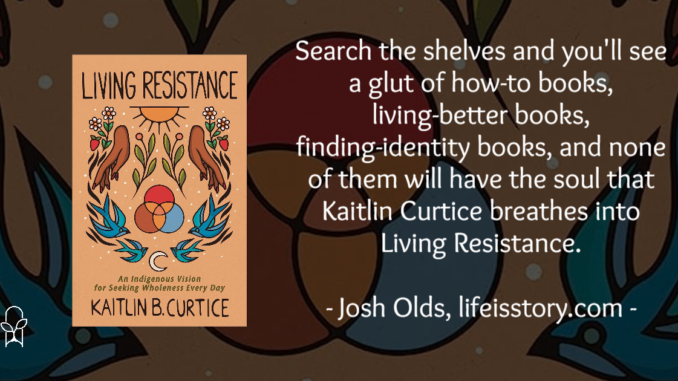
Published by Brazos Press on March 7, 2023
Genres: Non-Fiction, Christian Life
Buy on Amazon
Goodreads

In an era in which "resistance" has become tokenized, popular Indigenous author Kaitlin Curtice reclaims it as a basic human calling. Resistance is for every human who longs to see their neighbors' holistic flourishing. We each have a role to play in the world right where we are, and our everyday acts of resistance hold us all together.
Curtice shows that we can learn to practice embodied ways of belonging and connection to ourselves and one another through everyday practices, such as getting more in touch with our bodies, resting, and remembering our ancestors. She explores four "realms of resistance"--the personal, the communal, the ancestral, and the integral--and shows how these realms overlap and why all are needed for our liberation. Readers will be empowered to seek wholeness in whatever spheres of influence they inhabit.
This is not just a book you read; it’s a book that you live. Search the shelves and you’ll see a glut how-to books, living better books, finding identity books and none of them will have the soul that Kaitlin Curtice breathes into Living Resistance. It’s rare that I struggle to write a book review. I write hundreds of these a year. I know how to describe and analyze a book. But this book almost defies description because while I think I could open the book and give you a summary of the contents, I don’t think that I can truly replicate the feelings I felt when reading this. But I’ll try.
The first two feelings I felt were relief and permission. Relief because Living Resistance begins with the reminder that we are all on a journey—we are always becoming. Permission because that means it’s okay to not be there yet. It’s okay to struggle. It’s okay to be in the process. In the introduction, Kaitlin Curtice writes: “Our children get bullied at school so we fight the toxic forces of racism and patriarchy; we leave the fundamentalist upbringing we grew up in because we come to honor the integrity and humanity of our gender-nonbinary and trans friends; we attend our first Black Lives Matter protest and realize that we haven’t done enough to actively fight against systems of white supremacy’s legacy lived out in ourselves; we are made aware of our ableism and begin to dismantle the systems and very staircases that aren’t accessible to everyone.” That resonated with me because it’s been my experience. But then what do we do? The rest of Living Resistance offers some suggestions.
Living Resistance is divided into four sections: the personal realm, the communal realm, the ancestral realm, and the integral realm. Curtice devotes five chapters of 7-11 pages to each of these four realms. In the personal realm, I most identified with the chapter on art as resistance. In an increasingly technologically-driven society, art is both excessively commodified and minimized. Curtice offers a reminder of how artistic expression matters and can create real and lasting change. In the communal realm, I appreciate how she spoke of childcare as resistance. I have been a gymnastics coach, youth pastor, and stay-at-home dad. The way that Living Resistance speaks of children at child-raising is life-giving. Every chapter, every issues discussed in this book could have been its own volume. Curtice’s short snippets offer readers an engaging introduction and a desire to know and do more.
The best way to read Living Resistance is one chapter a day—maybe even one chapter a week. Each chapter ends with an encouragement toward a practical tip for resistance. Nothing hard, nothing too difficult, but something real and tangible. Something that moves you along in the process of becoming. A lot of times we can become paralyzed by thinking that there’s nothing we can do. We, as an individual, can rarely move the needle on any of these big issues. But part of what Living Resistance reminds us is that resisting the world also changes us for the better. We may not improve the global situation (or we might!), but we will improve ourselves. Resistance isn’t about winning, it’s about being faithful. By giving readers small, simple suggestions for practical change, Curtice points them on the way. Resistance isn’t necessary an action, it’s a way of being. Living Resistance captures that wonderfully. This is book to soak in slowly, turn the last page, then immediately begin afresh.
